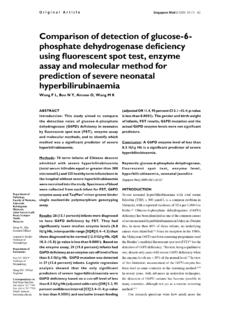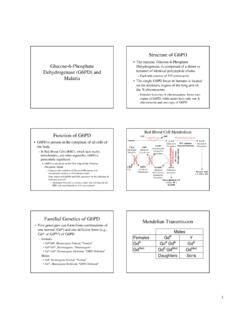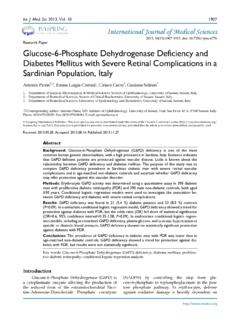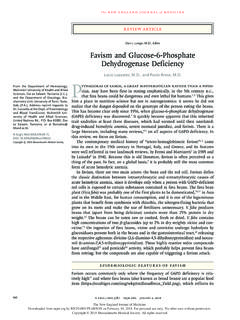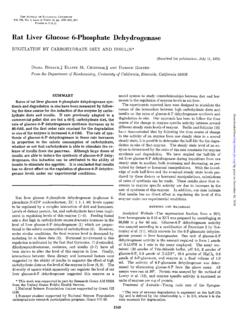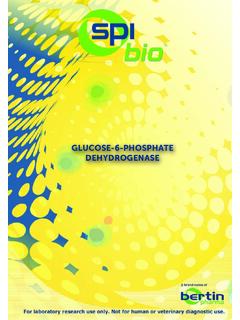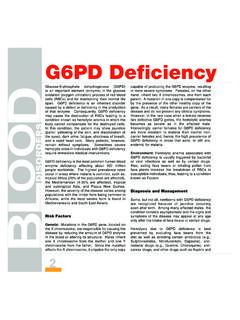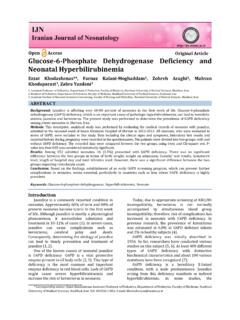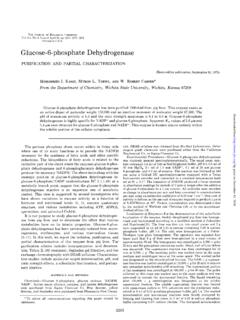Transcription of Brucellosis Triggering Hemolytic Anemia in Glucose-6 ...
1 Fax +41 61 306 12 34E-Mail Case Report Med Princ Pract 2009;18:329 331 DOI: Brucellosis Triggering Hemolytic Anemia in Glucose-6 - phosphate dehydrogenase Deficiency Gulsum Emel Pamuk a Aygul Dogan Celik b Mehmet Sevki Uyan k c a Division of Hematology, b Department of Clinical Bacteriology and Infectious Diseases and c Department of Internal Medicine, Trakya University Medical Faculty, Edirne, Turkey Introduction Brucellosis is a zoonotic infection caused by small, fas-tidious Gram-negative coccobacilli of the genus Brucella [1] . It has a worldwide distribution and is endemic in the Mediterranean basin and some developing countries [2] . Humans may be infected through the ingestion of raw milk, cheese, and insufficiently cooked or raw meat. The disease might also be acquired through direct contact with infected animals, products of conception, or animal excreta [1, 2] . Brucellosis may involve any organ system, but the most common complication is osteoarticular involve-ment.
2 It might also involve hepatosplenomegaly, the ner-vous system, the genitourinary system, the skin, or the respiratory system [3] . In addition, Brucellosis might have various hematological manifestations such as Anemia , leukopenia, lymphomonocytosis and, rarely, thrombo-cytopenia, pancytopenia, and thrombotic microangiopa-thy [3 6] . T he c au s e s of pa nc y top en ia a nd a nem ia i n br u-cellosis might be hemophagocytosis, hypersplenism, bone marrow granulomas, bone marrow hypoplasia, im-mune destruction, and infiltration with malignant dis-eases [3, 5, 6] . Glucose-6 - phosphate dehydrogenase (G6PD) defi-ciency is the most common red blood cell enzyme defi-ciency worldwide. It may lead to acute Hemolytic Anemia Key Words Glucose-6 - phosphate dehydrogenase deficiency Brucellosis Acute Hemolytic Anemia Abstract Objectives: To present a case of acute Brucellosis Triggering acute Hemolytic Anemia in a subject with Glucose-6 - phos -phate dehydrogenase (G6PD) deficiency.
3 Clinical Presen-tation and Intervention: A 17-year-old male patient pre-sented with fever, malaise and jaundice. His blood and bone marrow cultures yielded Brucella species. In addition, he was found to have acute Hemolytic Anemia due to previ-ously undiagnosed G6PD deficiency. He was started on folic acid supplementation and given a combination of doxycy-cline and rifampicin for 6 weeks. His response to antibiotic therapy was optimal; the Hemolytic Anemia resolved. There were no further episodes of hemolysis. Conclusion: This case showed that the differential diagnosis of acute hemo-lytic Anemia in subjects with G6PD deficiency should in-clude Brucellosis , especially in regions where the infection is endemic. Copyright 2009 S. Karger AG, Basel Received: August 5, 2008 Revised: November 19, 2008 Dr. Gulsum Emel Pamuk Eski Y ld z Cad. Park Apt. No:24 Daire:18 Besiktas-Istanbul (Turkey) Tel. +90 284 235 0001, Fax +90 284 235 7475E-Mail 2009 S.
4 Karger AG, Basel1011 7571/09/0184 0329$ Accessible online Pamuk /Dogan Celik /Uyan k Med Princ Pract 2009;18:329 331 330triggered by infection, the ingestion of certain drugs or broad beans (favism) [7] . Until recently, acute Hemolytic Anemia triggered by acute Brucellosis in G6PD deficiency has not been reported. Herein, we describe a patient with acute Brucellosis and G6PD deficiency concurrently that resulted in acute Hemolytic Anemia . C a s e R e p o r t A 17-year-old male was hospitalized in our Clinical Bacteriol-ogy and Infectious Diseases Clinic in November 2005 with the complaints of malaise, fever of 2 weeks duration, sweating, low back pain, headache, jaundice, and darkening of urinary color of 1 week s duration. He had been living in a village in the Edirne Province in the northwest of Turkey. The patient was a shepherd and his family herded sheep. He admitted consuming raw dairy products and having direct contact with the animals.
5 His past medical history was not contributory: he denied the intake of any drugs, any infectious diseases or favism. His family history re-vealed cholecystectomy and splenectomy in 2 of his maternal un-cles in the third decades of their lives. His initial vital signs were as follows: temperature C; blood pressure 110/60 mm Hg; heart rate 132/min, and respiratory rate 32/min. On physical ex-amination, conjunctivae were pale, sclerae were subicteric, andthe skin appeared yellow. Cervical and axillary lymph nodes were 2 cm in their greatest diameter and splenomegaly and hepatomeg-aly were evident (9 and 4 cm below the respective costal margin). There was a grade II/VI systolic murmur in the mitral and pulmo-nary areas; examination of the respiratory system was normal. Neurologic system evaluation revealed no pathology. Whole blood count showed hemoglobin g/dl, hematocrit , mean cor-puscular volume fl, leukocytes 4,200/mm 3 , and platelets 208,000/mm 3.
6 The peripheral blood smear revealed polychroma-sia and nucleated red blood cells, but no schistocytes. The leuko-cyte differential was composed of 3% myelocytes, 3% metamyelo-cytes, 4% stabs, 38% neutrophils, 2% basophils, 48% lymphocytes, and 2% monocytes. On biochemical analysis, total bilirubin was mg/dl (normal ! mg/dl), indirect bilirubin mg/dl (nor-mal ! mg/dl), and lactate dehydrogenase 440 U/l (normal ! 192 U/l). Other biochemical values including urea, creatinine, electro-lytes, ALT, AST, ALP, GGT were normal. Erythrocyte sedimenta-tion rate was 55 mm/h and C-reactive protein mg/dl (normal: 0 mg/dl). Bone marrow aspiration was hypercellular with ery-throid hyperplasia (myeloid:erythroid ratio 43: 41) and toxic gran-ulation of the myeloid cells. The corrected reticulocyte count was and serum haptoglobin level was low ( ! mg/dl). There was increased urinary urobilinogen, but no hemosiderinuria. Di-rect and indirect Coombs tests were negative; serum vitamin B 12 and folic acid levels were normal.
7 The value of G6PD was IU/g hemoglobin (normal: IU/g hemoglobin). Any forms of Plasmodium spp. were not s e en on t he per ipher a l blood sme a r pre-pared on three separate occasions when the patient had high fever. Serologic tests for HBsAg, antiHBs IgG, antiHBc, antiHCV, anti-HIV, antiCMV IgM and IgG, antitoxoplasma IgM and IgG, and the monospot and Grubal-Widal tests were negative. Serum slide agglutination (Rose-Bengal) test was positive, and the standard tube agglutination (Wright) test for Brucella spp. was positive at a titer of 1/20,480 on the 4th day of admission. The antigens in these tests (obtained from Pendik Veterinary Research Laboratory, stanbul, Turkey) were prepared from B. abortus S-99 strain. Bru-cella species were isolated from both blood and bone marrow cul-tures on the 9th day of admission. The species of Brucella could not be identified because further identification tests for Brucella strain could not be performed.
8 The patient was diagnosed with acute Hemolytic Anemia due to G6PD deficiency triggered by acute Brucellosis . Thorax com-puted tomography (CT) revealed only axillary lymph nodes 2 cm in maximal diameter. Abdominopelvic CT showed hepatomegaly (19 cm) and splenomegaly (20 cm). Electrocardiography and cra-nial CT were normal. Radiographic studies of the spine and sac-roiliac joints showed no pathology. The patient was started on folic acid after the initial laboratory tests indicated nonimmune hemolysis. He was put on doxycycline 200 mg/day and rifampicin 600 mg/day after the positive tube agglutination test. His fever continued during the first 5 days of antibiotic therapy. After 1 week of antibiotic therapy, his hemoglobin level was g/dl, he-matocrit , leukocytes 3,300/mm 3 , platelets 118,000/mm 3 , corrected reticulocytes , lactate dehydrogenase 1,565 U/l. He was transfused with 2 units of red blood cell suspensions.
9 Thereafter, his whole blood count parameters began to improve and his hemolysis stopped. He was discharged after 2 weeks of antibiotic therapy and completed therapy with doxycycline and rifampicin for 6 weeks. On his last follow-up in May 2008, nearly years after his initial presentation, he was well, with no com-plaints and complications; he had a normal whole blood count with no hemolysis and normal biochemical tests. The patient s two follow-up G6PD levels were lower than his initial value. Discussion Brucellosis is a multisystemic infectious disease with a worldwide distribution [1] . Patients with active brucel-losis might have various hematological manifestations such as Anemia , leukopenia, and relative lymphomono-cytosis [3, 4] . Less frequently, there might be thrombocy-topenia, pancytopenia, and hemolysis [5, 6, 8] . Anemia and pancytopenia in Brucellosis might be ex-plained by different mechanisms.
10 One of the causes is hemophagocytosis [6, 9] . In one large series including 202 patients, more than half of the bone marrow aspirations and biopsies showed histiocytic hyperplasia with promi-nent phagocytosis of erythrocytes, leukocytes, platelets, and their precursors [6] . Another cause is bone marrow gra nu lomas which have no caseation necrosis [9] . Hyper-splenism might be a contributory factor for cytopenias. However, the spleen is usually not huge and cytopenias improve before resolution of splenomegaly, and therefore it seems to play a minor role [6] . Bone marrow hypoplasia is a rarely reported cause for cytopenias. Infiltration of the bone marrow with solid or hematological malignan-cies might also result in cytopenias in Brucellosis patients Hemolytic Anemia due to Brucellosis Med Princ Pract 2009;18:329 331 331 [6] . Immune mechanisms have been suggested to be re-sponsible in some cases [5, 10] . One rare cause for Anemia in Brucellosis is hemolysis, generally in the form of microangiopathic Hemolytic ane-mia [11].
